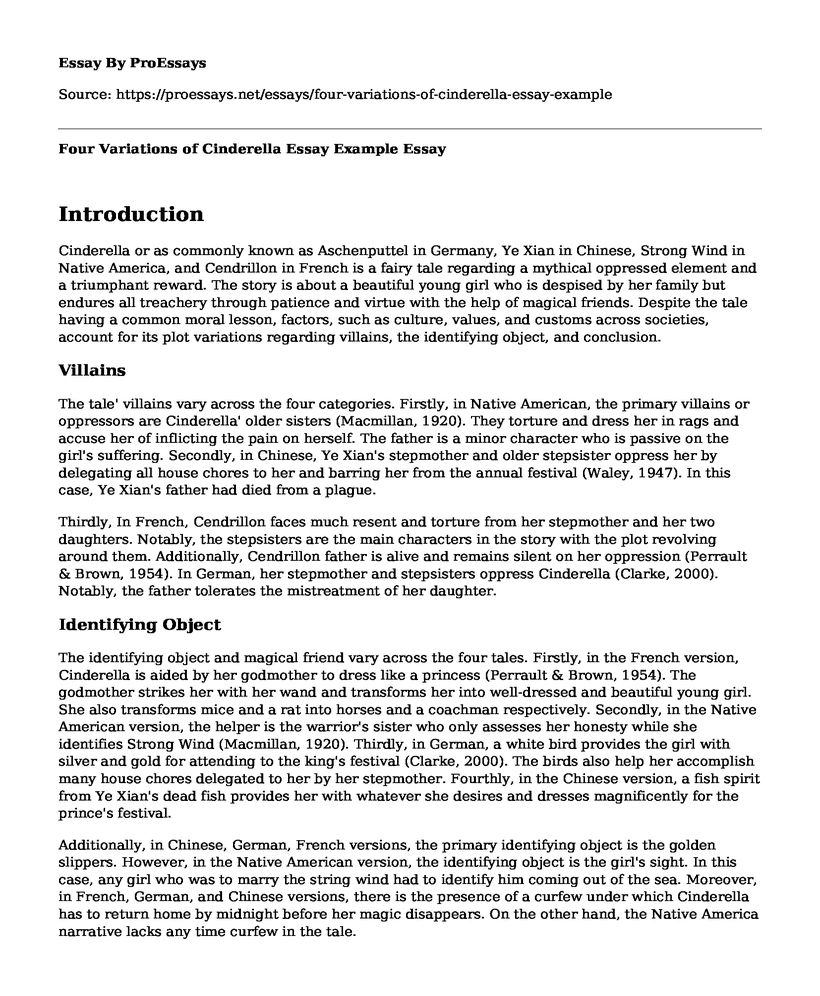Introduction
Cinderella or as commonly known as Aschenputtel in Germany, Ye Xian in Chinese, Strong Wind in Native America, and Cendrillon in French is a fairy tale regarding a mythical oppressed element and a triumphant reward. The story is about a beautiful young girl who is despised by her family but endures all treachery through patience and virtue with the help of magical friends. Despite the tale having a common moral lesson, factors, such as culture, values, and customs across societies, account for its plot variations regarding villains, the identifying object, and conclusion.
Villains
The tale' villains vary across the four categories. Firstly, in Native American, the primary villains or oppressors are Cinderella' older sisters (Macmillan, 1920). They torture and dress her in rags and accuse her of inflicting the pain on herself. The father is a minor character who is passive on the girl's suffering. Secondly, in Chinese, Ye Xian's stepmother and older stepsister oppress her by delegating all house chores to her and barring her from the annual festival (Waley, 1947). In this case, Ye Xian's father had died from a plague.
Thirdly, In French, Cendrillon faces much resent and torture from her stepmother and her two daughters. Notably, the stepsisters are the main characters in the story with the plot revolving around them. Additionally, Cendrillon father is alive and remains silent on her oppression (Perrault & Brown, 1954). In German, her stepmother and stepsisters oppress Cinderella (Clarke, 2000). Notably, the father tolerates the mistreatment of her daughter.
Identifying Object
The identifying object and magical friend vary across the four tales. Firstly, in the French version, Cinderella is aided by her godmother to dress like a princess (Perrault & Brown, 1954). The godmother strikes her with her wand and transforms her into well-dressed and beautiful young girl. She also transforms mice and a rat into horses and a coachman respectively. Secondly, in the Native American version, the helper is the warrior's sister who only assesses her honesty while she identifies Strong Wind (Macmillan, 1920). Thirdly, in German, a white bird provides the girl with silver and gold for attending to the king's festival (Clarke, 2000). The birds also help her accomplish many house chores delegated to her by her stepmother. Fourthly, in the Chinese version, a fish spirit from Ye Xian's dead fish provides her with whatever she desires and dresses magnificently for the prince's festival.
Additionally, in Chinese, German, French versions, the primary identifying object is the golden slippers. However, in the Native American version, the identifying object is the girl's sight. In this case, any girl who was to marry the string wind had to identify him coming out of the sea. Moreover, in French, German, and Chinese versions, there is the presence of a curfew under which Cinderella has to return home by midnight before her magic disappears. On the other hand, the Native America narrative lacks any time curfew in the tale.
Story Ending
All the above narrative's conclusions differ despite having a common happy-ending for Cinderella. In the Chinese version, the king banishes Ye Xian's stepfamily into the wilderness, where they lived unhappily and killed by a storm (Waley, 1947). In the Native American, Strong Wind punishes Cinderella's cruel sisters by turning them into aspen trees. Thirdly, in the French version, Cinderella forgives her stepfamily after they plead for mercy (Perrault & Brown, 1954). Additionally, two handsome men from the royal court marry her two stepsisters. Fourthly, in the German version, Aschenputtel's magical doves peck off her stepsisters' eyes during her wedding as a form of punishment (Clarke, 2000).
Conclusion
Overall, Cinderella folktale exists in many versions across the world. Its moral lesson encourages patience, integrity, and endurance. In the above four versions, the narrative changes to adapt to local cultures. However, they unite in narrating the triumph of good over evil in the society.
References
Clarke, M. M. (2000). Bronte's" Jane Eyre" and the Grimms' Cinderella. Studies in English Literature, 1500-1900, 40(4), 695-710.
Macmillan, C. (1920). Canadian wonder tales. London: J. Lane; Toronto: SB Gundy.Perrault, C., & Brown, M. (1954). Cinderella, or, The little glass slipper. New York: Scribner.Waley, A. (1947). The Chinese Cinderella Story. Folklore, 58(1), 226-238.
Cite this page
Four Variations of Cinderella Essay Example. (2022, Sep 22). Retrieved from https://proessays.net/essays/four-variations-of-cinderella-essay-example
If you are the original author of this essay and no longer wish to have it published on the ProEssays website, please click below to request its removal:
- Essay Example on Euthanasia and Reasons for It to Stay Illegal
- Essay Example on Cybersecurity Issues
- Paper Example on Program of YSB
- Paper Example on EBP in Mental and Behavioral Health Facility
- Education and Cyber Security Awareness Essay
- Biased Research: A Major Cause of Wrong Decision-Making
- Essay Example on Caring for Traumatic Brain Injuries: Understanding Severity and Characteristics







